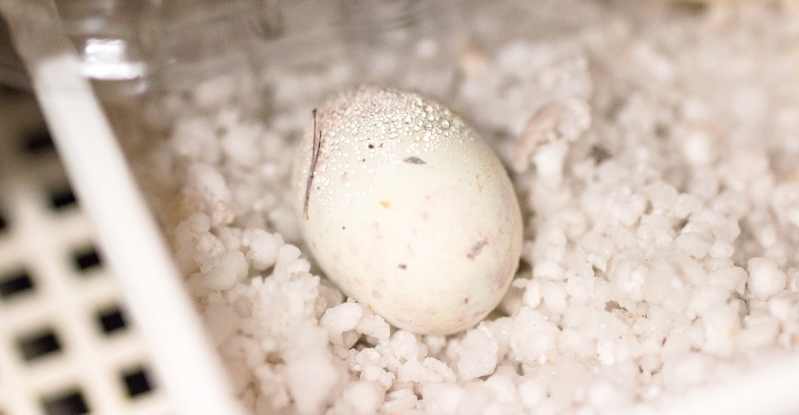Oviposition, incubation and hatching
The oviposition takes place onshore approximately six to eight weeks after mating. The clutch of eggs – three to 12 eggs per animal, 8 eggs per animal on average – have always been laid closely side by side on the dry part of the ‘land part’ or the shelter so far. The eggs are of oval shape, approx. 3 cm in length and have a leathery skin. Thus far, a burial of the eggs by the female earless monitor lizard could have never been observed over the long-term animal farming over a period of several generations. However, it is to be mentioned, that female earless monitor lizards already stay ashore in direct proximity of the later nesting site a few days prior to the oviposition and leave not until a few hours following the oviposition. The oviposition takes several hours, while usually two eggs respectively are laid at 30 to 45 minutes intervals.

The clutch of eggs itself is extremely vulnerable with regard to the environmental impact (fluctuations in humidity and temperature) which could lead to the fact that the eggs become mouldy or wither owing to slight fluctuations in environmental conditions. Therefore, it is to be ensured that the terrarium offers several, different nesting sites and the clutch of eggs will be brought to an ‘ideal’ incubation environment as soon as possible. Yet a total loss of a clutch of eggs cannot be ruled out. After the eggs were extremely cautiously been taken out of the terrarium, they will be placed in plastic boxes on customary substrate (Perlit) with a distance of a few centimetre with an average temperature of 28-29°C (with a respective night mode reduction to 25°C for several hours) and approx. 85 % humidity and hatched in a professional incubator. In this context, it must be ensured that the eggs will under no circumstances come in direct contact with water. If eggs come in direct contact of water, or the deposition of eggs or the substrate is too humid, it regularly leads to the loss of one or the entire clutch of eggs. The same may occur in the case of a too dry storage during the incubation phase. A high level of sensitivity and continuous monitoring of the breeding conditions is required.
The forthcoming hatching of the young animals loom up by a slight red colouration of the eggs associated with the creation of tiny water drops on the eggshell after approx. 80 days under constant breeding temperature – after 95 to 100 days with regular night mode reduction.

The hatching of the small earless monitoring lizards extends over a period of several days. Thereby, a small crack in the eggshell develops from which egg fluid emerges on the first day. The small lizards will gradually enlarge this crack with their snout, whereas an egg tooth could not be observed. After the first day, the small earless monitor lizards already stretch parts of their snout and of their head out of the egg. In case they feel disturbed, they withdraw completely into the eggshell again.

On the second day, the head and the entire upper part of the body finally reach the outside, while the hasty withdrawal into the eggshell could be repeated in case of a disturbance. They leave the eggshell on the third day, whereas the final phase occurs almost with panic at the end.
